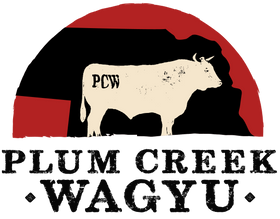The Origins and Types of Wagyu
Wagyu, translating to 'Japanese cow', refers to specific breeds of cattle in Japan, including the Japanese Black, Japanese Brown, and Japanese Shorthorn. Among them, the Japanese Black breed, known for producing the famed A5 Wagyu, is particularly celebrated for its extraordinary marbling. Wagyu has now found a home outside Japan as well, with American Wagyu and Australian Wagyu emerging as popular varieties, developed by cross-breeding Japanese Wagyu cattle with domestic breeds.

Japanese Wagyu and Kobe Beef
Japanese Wagyu is renowned for its strict breeding methods and feeding techniques, resulting in beef with unparalleled marbling and flavor. Kobe beef, a type of Japanese Wagyu from the Hyogo Prefecture, is one of the most prestigious and sought-after varieties. It's known for its tender texture, flavor, and well-distributed intramuscular fat.
American Wagyu
The American Wagyu Association oversees the breeding of Wagyu in the USA. American Wagyu, often a cross between Japanese Wagyu and Angus cattle, offers a different but equally exquisite taste profile, balancing the marbling of Wagyu with the bold flavors of American beef.
Health Aspects of Wagyu
Wagyu beef's marbling is not only about taste but also includes health benefits. It's rich in monounsaturated fats, particularly oleic acid, and lower in saturated fats compared to regular beef. This composition contributes to a healthier profile of fatty acids in Wagyu.
Wagyu's Unique Marbling
The marbling in Wagyu is what sets it apart. This fat composition gives Wagyu its buttery flavor and tender texture. Unlike the fat in regular beef, Wagyu's marbling melts at a lower temperature, providing a unique taste experience.

Raising Wagyu
Wagyu farmers in Japan and elsewhere follow strict guidelines to raise Wagyu cattle. The process includes specialized feed and care to ensure the highest quality of meat. Wagyu genetics play a significant role in the beef's quality, with Wagyu farmers focusing on preserving these unique traits. Learn more about raising Wagyu & their feeding practices.

Wagyu in Cuisine
Wagyu's versatility makes it a favorite in both Japanese and Western cuisines. Wagyu steak is a popular way to enjoy this meat, allowing the natural flavors to shine through. In Japan, Wagyu is often prepared in traditional dishes, offering a distinct flavor that's celebrated globally.
This versatile meat is celebrated for its ability to adapt to various cooking styles and dishes, making it a prized ingredient in the global culinary scene.
Wagyu in Western Cuisine
- Grilled Wagyu Steaks: In Western cuisine, grilling is a popular method to prepare Wagyu steaks. Cuts like Ribeye, New York Strip, and Sirloin are grilled to perfection, allowing the natural marbling to add depth and richness to the flavor.
- Roasted Wagyu: Larger cuts of Wagyu, such as the Chuckeye roast or Tenderloin, are often oven-roasted, creating a luxurious centerpiece for special occasions.
- Wagyu Burgers: Ground Wagyu beef makes for an indulgent upgrade to the classic burger. The rich marbling in the meat ensures a juicy, flavorful patty that's a cut above the typical beef burger.
The Role of Wagyu Steaks in Different Cuisines Each type of Wagyu steak brings something unique to the table:
- Wagyu Ribeye: Known for its incredible marbling and tenderness, Wagyu Ribeye is a favorite in both Japanese and Western cuisines. It's often grilled or pan-seared to highlight its rich, buttery flavor.
- Wagyu Sirloin: A leaner cut, Wagyu Sirloin is versatile and can be prepared in a variety of ways, from quick grilling to slow roasting.
- Wagyu Tenderloin: The most tender cut, Wagyu Tenderloin is a premium choice for special dishes. Its delicate flavor and buttery texture make it a sought-after cut for fine dining experiences.

The story of Wagyu is one of heritage, quality, and excellence. Each cut of Wagyu beef embodies the dedication of its farmers and the rich history of Japanese cattle rearing which results in its marbling and flavor to its health benefits and cultural significance. As Wagyu continues to charm food enthusiasts around the world, it remains a testament to the dedication of Wagyu farmers and the rich history of Japanese cattle rearing.
Related Posts
Wagyu Myths Debunked: Separating Fact from Fiction
Think you know Wagyu? Think again! We’re debunking common myths about Wagyu beef, from its origins to its marbling, grading, and price.
Why Wagyu Beef is Worth the Price: A Breakdown of Quality and Value
Is Wagyu beef really worth the price? Discover what makes Wagyu stand out from other premium meats, from superior marbling to unmatched flavor and tenderness.
What is F1, F2, and Fullblood Wagyu? Understanding Wagyu Genetics
Not all Wagyu is the same! Learn the differences between F1, F2, and Fullblood Wagyu, and discover how genetics impact marbling, flavor, and beef quality.
Wagyu on the Grill: Tips for a Sizzling Summer BBQ
Fire up the grill! Learn expert tips for grilling Wagyu beef to perfection, from the best cuts to seasoning and cooking techniques that maximize flavor and tenderness.
How to Render Wagyu Fat and Use It in Your Cooking
Don’t let Wagyu fat go to waste! Learn how to render Wagyu fat and use it to enhance your cooking—perfect for frying, roasting, and adding rich flavor to any dish.
The Ultimate Wagyu Burger: How to Build the Perfect Bite
Elevate your burger game with the ultimate Wagyu burger! Discover the best buns, toppings, and sauces to complement the rich, buttery flavor of Wagyu beef and build the perfect bite.








